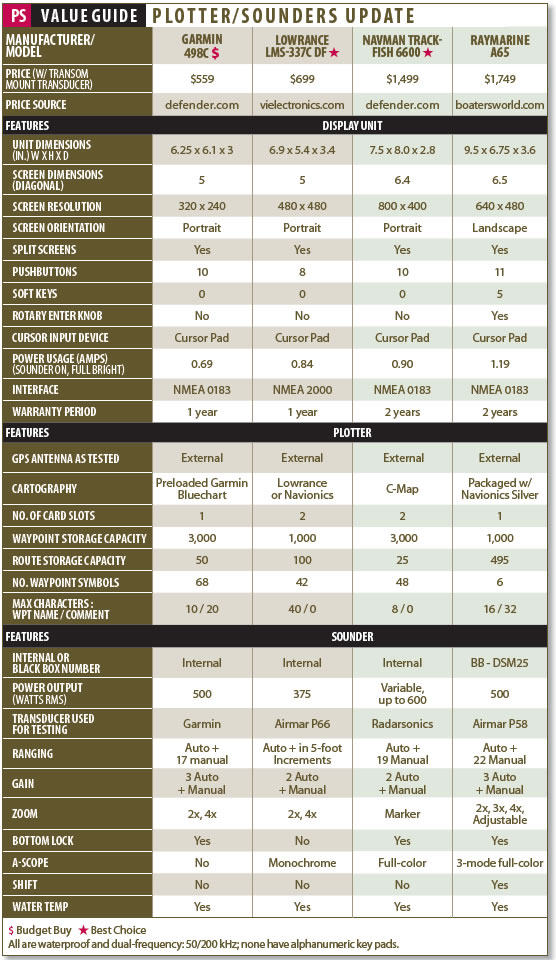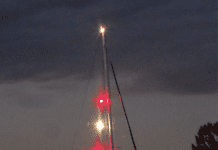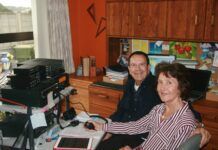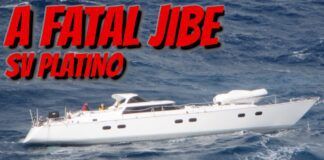In an effort to keep our readers informed of happenings in the marine electronics field, Practical Sailor is constantly on the lookout for new products and those that are a good value, even though they may have been on the market for several years. This update to our list of tested plotter/ sounder combo units does just that. Editors test drove the Garmin 498C and Raymarine A65, comparing them to the top performers among small-screen plotter/sounders and large-screen plotter/sounders. The Garmin plotter/sounder faced off with the Lowrance LMS-337C DF, and the Raymarine plotter/sounder combo was compared to the Navman Trackfish 6600. Testers considered each chartplotters user-interface and viewability, as well as their depth sounder features, including ability to show bottom detail, ease of use, and array of features.
****
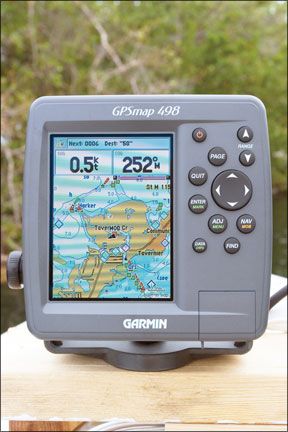
In an effort to keep our readers informed of happenings in the marine electronics field,
Practical Sailor is constantly on the lookout for new products and those that are a good value, even though they may have been on the market for several years. This update to our list of tested plotter/sounder combo units does just that as we look at one unit that has recently hit the market and another making its final march.
Weve discussed before the many advantages that fishfinders have for cruising sailors. It boils down to having the benefit of a visual representation of bottom contours. This can be priceless information in an unfamiliar harbor or a backwater anchorage.
What We Tested
In the April and June 2006 issues of Practical Sailor, we reported on nine plotter/sounder combo units. At that time, our test was divided into two groups based on screen sizes of approximately 5 and 6.5 inches. In this update test, we review one unit from each category—the Garmin 498C (5-inch screen) and the Raymarine A65 (6.5-inch screen)—against the 2006 top performers in their respective categories. The Garmin faced off with the Lowrance LMS-337C DF, and Raymarine A65 was compared to the Navman Trackfish 6600.

The Lowrance got testers top pick in the previous test based on its fine sounder detail, high-resolution screen, powerful software, top-notch MOB function, NMEA capability, and its reasonable price.
The Navman was tops among the big screens in the 2006 test thanks to its sharply defined display, user-friendly and powerful software, and the ease with which split screens can be re-sized.
How We Tested
Both units were mounted on a portable base for side-by-side comparison and then temporarily strapped on a skiff. We reviewed and rated the viewability of each unit. In the daylight, each screen was viewed from various angles, with and without polarized sunglasses, and from differing sun angles. Night viewing was done after sunset with an eye toward the quality and adjustability of the units backlighting. Testers viewed these displays from 2 to 3 feet away.
We rated each chartplotter for user-interface based on the units buttons, cursor pad, and most importantly, software. The easier and more intuitive a unit was to use, the higher we rated it. We used each units supplied GPS antenna to receive satellite position signals. Both of our test units were equipped with external antennas; they were mounted in close proximity to minimize variations in position data. As we maneuvered our skiff, testers entered waypoints, edited them, deleted them, and checked man-overboard functionality. We also set up a 15-waypoint route from a creek out in to the Gulf of Mexico to assess route building and usage abilities.
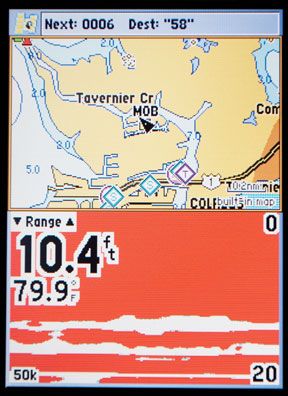
Sounders were evaluated over known bottom structure in water depths from 2 to 35 feet. We used the transom-mount transducer that was shipped with each unit to accomplish our review. All sounder testing was done in 80-degree salt water. Sounders were judged on their ability to show bottom detail, their ease of use, and their array of features.
Power usage was measured with a Sperry multimeter with the sounder pinging away and the screen set at maximum daylight brightness.
Garmin 498C
Our test version of the Garmin 498C was factory-equipped with an external GPS antenna, an integral sounder, and a dual-frequency transducer. Other models of the 498C are available with an internal GPS antenna. The unit is pre-loaded with Garmin BlueChart cartography that covers U.S. waters in great detail.
We used the supplied bracket to mount the 498C display unit to the test board and found the installation to be straightforward and secure. All wiring for power, interface, and transducer leads attaches to the back of the unit with a single multi-pin twist-lock connector. The transducer branch connects to the transducer with another inline twist-lock connector while the GPS antenna connects via a pre-wired BNC connector. We found the installation simple and straightforward.
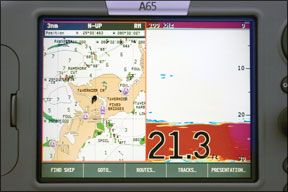
The Garmin 498C screen measures 4 inches high and 3 inches wide. It has a 320 x 240-pixel resolution, so details are not as sharp as on higher-resolution screens like the Lowrance LMC-337C DF.
Fourteen levels of control are available for screen brightness. In daylight conditions, we found the 498C easy to see and read. However, it showed a moderate amount of screen darkening when viewed through polarized sunglasses. We rated the screen Good for daytime viewability and Excellent for night-time viewability. Pushbuttons and the cursor pad are backlit.
Typical of Garmin devices, most of the 498Cs functions are reached through multi-layered menus. Holding the menu key in for a couple of seconds brings up the main menu with its long tab list of items on the left side of the screen. Selecting a tab with the cursor opens another menu page, where you can make and execute specific selections.
A waypoint can be saved at the boats present position by pressing and holding the Enter/Mark key until the New Waypoint menu appears or at the cursor position with a quick press of the same button. The waypoint information box lists the symbol selected for the waypoint (a long list of named symbols are available); a name up to 10 characters long; a 20-character comment; latitude/longitude; and bearing/distance. The user can modify any of the information.
Route entry can be accomplished using a text listing of waypoints or by selecting points on the map page. We used the quick route navigation function to quickly create a route on the map page using only the cursor and the enter button.
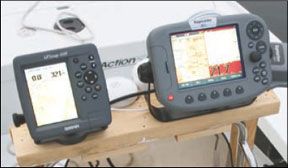
Garmins man overboard function is activated by pressing the MOB key. The unit then asks the user to confirm whether he wishes to navigate to the MOB point. When you answer in the affirmative, the unit executes the command. No really useful information is offered on the map page unless you have already set up appropriate data blocks. We had not done this, so we found it easiest to switch to the compass page to navigate back the MOB position.
A number of different pages are displayed by pressing the page button. The factory-setup includes map, map/sounder split screen, sounder, compass, and 3D highway. The map can be oriented north up, track up, or course up. Additional options for the displayed page can be selected by hitting the menu key once. This brings up the page-specific menu.
The 500-watt sounder integral to the 498C includes a dual frequency transducer (50/200 kHz) and a list of features including auto and manual depth ranging, zoom, bottom lock, and water temperature display. A desirable feature found on the 498C, as well as other Garmin sounders weve tested, is the active cursor control. Pushing the side arrows on the cursor allows the user to quickly select an array of functions and then adjust them with the up/down arrows.
Six functions are available with the active cursor: gain, color gain, depth range, frequency, Ultrascroll, and Whiteline. We rated the Garmin 498C sounder Good for presentation and Excellent for ease of use.
Bottom Line:
At $559, the Garmin 498C earns our Budget Buy pick with good functionality, decent screen resolution, pre-loaded cartography, and an easy to use sounder at a low price.
Raymarine A65
We received our Raymarine gear in the A65 System Pack, which includes the A65 display unit, a DSM25 black box sounder, a Navionics Silver U.S. All-In-One Marine chart card, and a dual-frequency transducer.
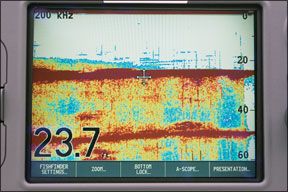
We used the supplied metal bracket to mount the A65 display unit to the test board. The black black-box sounder module was screwed to the test board, too. A flush-mounting kit is available as an option. All the wire connections from the black box, power cable, and GPS unit are made with multi-pin twist-lock connectors. Installation was simple.
The A65s landscape screen measures just under 4 inches high by 5 inches wide and has a high resolution of 640 x 480 pixels. Details appear to have very sharp edges when viewed from within 3 feet. At farther distances, some fine details get too small to discern easily. We viewed the unit with the white background color selected during daylight operations. A blue background is also available, and several other colors are available for the sounder view. Brightness is controlled from 0 to 100 in 20 steps. Viewability was fine even with very high levels of sunlight. We did, however, notice some screen darkening when we viewed the screen through polarized sunglasses. We rated the A65s viewability Good for daytime and Excellent for night-time.
Frequently used functions are launched with page-specific soft keys, a rotary entry device, and an enter-key-equipped cursor, leaving little need to go into the menus. Soft key functions are displayed above each of the soft keys and change to reflect the displayed page controls.
In the A65, first pressing the Wpts (waypoints) key and then choosing a course of action using the soft keys allows the user to save a waypoint at the current position or at the cursor position. A double press of the Wpts key shortcuts the process and creates an instant waypoint at that position. The waypoint list shows the selected symbol (one of six can be picked), a name up to 16 characters long, a 32-character comment, latitude/longitude, and bearing/distance for each waypoint. Any field in the waypoint data list can be modified as needed.
Route entry can be accomplished using stored waypoints, newly created waypoints, or a combination of new and stored waypoints. Up to 50 waypoints can be used in one route. We used only the cursor and soft keys to create a route. It was quick and easy. Routes can be tracked in either direction, and a user can select an orientation of north-up, course-up, or heading-up. All worked well in our test. The course predictor is a thin line and can be somewhat hard to see on a fully detailed map page.
Holding down the MOB key on the A65 sounds an alarm, marks the MOB position, and switches the display to a split screen showing the way back to the MOB. Data boxes show course over ground, heading, bearing, and distance, as well as cross-track error back to the MOB position. Holding the MOB key down again turns off the function.
This is the type of MOB function we like to see. Everything you need to get back to the MOB happens automatically, and it is virtually impossible to press any button on the machine that would screw things up.
The first push of the page button on the A65 yields two choices: chart or fishfinder. Hitting either of these soft keys allows the user to choose between full screen and a variety of split-screen configurations. When both the chart page and fishfinder are displayed in a split-screen arrangement, the active key switches control between the screens. The active window is outlined in red.
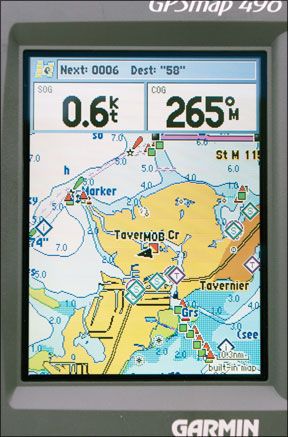
The DSM25 black-box sounder pushes 500 watts of power through an Airmar P58 dual frequency (50/200 kHz) transducer. Standard features include auto and manual depth ranging, zoom, bottom lock, and water temperature. Zoom on the A65 is very capable with 2x, 3x, 4x, and user-adjustable options. Bottom lock is also user adjustable in depth and presentation. Some more powerful features normally found only on high-end sounders are three-mode, full-color A-scope and shift. Gain has three auto settings as well as a manual range of zero to 100. Testers really liked that it can be adjusted with the rotary knob. We rated the Raymarine A65 sounder Excellent for both presentation and ease of use.
Bottom Line:
A top-flight machine that garnered Good to Excellent ratings across the board. It doesn’t out pace the leader though, because of its higher cost, $1,749. (It can be purchased without the sounder for several hundred dollars less.)
Conclusions
With a slew of new Garmin plotters and fishfinders hitting the market recently, older gear is getting cheap. As production on certain units ceases, prices begin to fall rapidly. One discontinued unit thats seen its price plummet is the Garmin 498C. Many of these remain in the retail distribution channel, so supply should be plentiful for months. This affords budget-minded boaters a chance to grab a highly rated unit at rock-bottom prices. Though it lacks the high resolution of our top-rated Lowrance LMS-337C DF, it makes up for it with good functionality and pre-loaded cartography. We rate it a Budget Buy, while the supply lasts.
The Raymarine A65 compares favorably to the Navman Trackfish 6600, but it does not overtake the leader, in our opinion. It has similar screen resolution and more sophisticated plotter and sounder software. The Raymarine also has five soft keys and a rotary knob. On the downside, the A65 costs considerably more, plus it has an extra black box to install.
